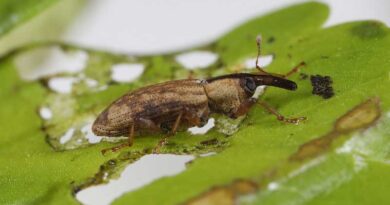New Green Herbicide Offers Hope Against a “Heartbreaking” Invasive Weed
08 February 2022, Colorado: Crested floatingheart plants are a decidedly poor choice for Valentine’s Day, scientists with the Weed Science Society of America (WSSA) say. This showy ornamental is a native of Asia and a popular selection for water gardens – prized for its large, heart-shaped leaves with a deep red border. Unfortunately, though, crested floatingheart can wreak havoc as a weedy aquatic invader if it escapes into natural settings.
Dense, vegetative mats formed by the plant can blanket canals, reservoirs and other bodies of water – degrading fish habitats, causing flooding, and interfering with recreational activities like swimming and boating.
Crested floatingheart is also notoriously hard to control. It can reproduce both from leaf fragments and from fingerlike ramets, which are vegetative structures that form underneath its leaves.
“Our lab studies show that on average, one crested floatingheart plant can produce 500 ramets in just six months,” says Lyn Gettys, PhD, an associate professor at the University of Florida. “Forty to 60 percent of those ramets will then sprout and produce ramets of their own, fueling exponential growth. Over a two-year timeframe, that can conservatively translate into about 80,000 new plants from a single mother plant.”
Attempts to mechanically remove crested floatingheart infestations can be heartbreakingly ineffective. Leaf fragments and ramets can simply sink to the bottom of the body of water and produce new plants. Until recently, few herbicides were available to control the weed effectively.
Those options were expanded, though, with the introduction of florpyrauxifen-benzyl, an active ingredient registered for the control of hydrilla. Aquatic pest managers have recently discovered that florpyrauxifen-benzyl can also deliver a knockout punch in the fight against crested floatingheart. “It’s a real game changer,” Gettys says.
The new chemistry is applied at very low rates. It has low persistence in soil and water and exhibits low toxicity to birds, insects, fish and other organisms. As a result, it has won multiple awards, including a Green Chemistry Challenge Award.
“The goal now is to use the herbicide responsibly to avoid the evolution of herbicide resistance,” Gettys says.
One of the most important strategies, she says, is to focus on prevention. Look for native plants for your water garden instead of exotic imports like crested floatingheart. And when you are enjoying water sports on a lake, reservoir or other body of water, thoroughly clean and dry your boat and other sports equipment so you won’t accidentally transport aquatic invaders to a new site.
Want to know more?
Here are additional fast facts about crested floatingheart (Nymphoides cristata):
- Crested floatingheart produces delicate white flowers with five petals and a central ridge or crest. There is a distinctive white ruffle in the middle of each petal, which aids in its identification.
- Confirmed U.S. infestations of crested floatingheart include sites in the Carolinas, Florida, Louisiana, Mississippi and Texas.
- Once the plant becomes established in a body of water, leaf fragments and ramets can be easily spread by wind, water movement, boats and other watersports equipment.
- Examples of its rapid spread: Crested floatingheart was first observed in Florida in the late 1990s in southeast cypress swamps and water management canals. Within a few years, large canals and suburban lakes in central and eastern Florida had also become infested. It was first detected in South Carolina in 2006, found in a 20-acre cove at the end of Lake Marion. By 2009, an estimated 2,000 surface acres of Lake Marion were infested. It was also found in nearby Lake Moultrie and along the Santee River.















